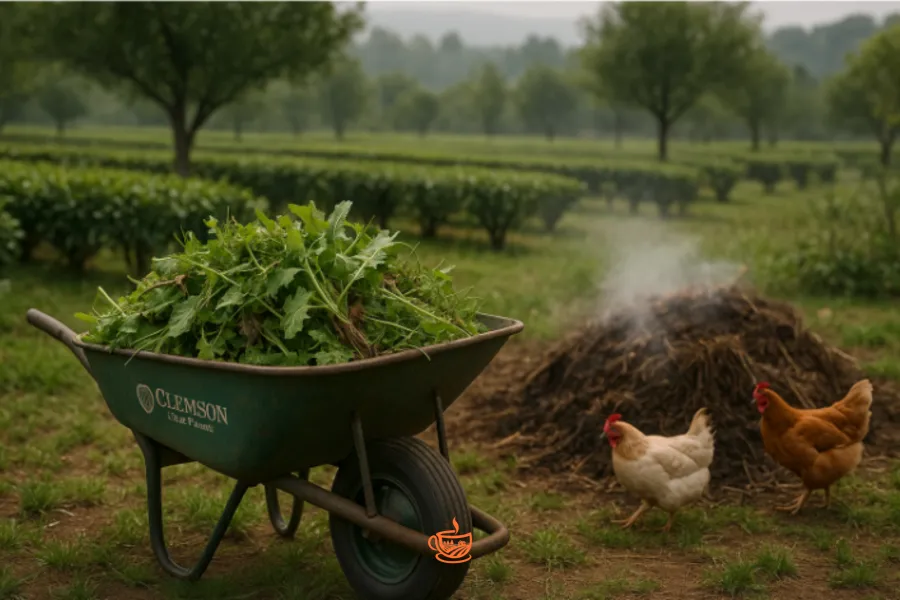
Turning Weeds into Compost Power
Don’t curse those weeds—compost them! Here’s how to turn garden nuisances into nutrient-rich compost fuel (without spreading seeds where you don’t want them).
From Menace to Miracle
Weeds happen. Whether it’s chickweed creeping in or dandelions popping up like eager volunteers, the instinct is often to yank and toss. But what if, instead of fighting weeds with frustration, you turned them into something downright miraculous—microbe-rich, soil-building compost?
At Clemson Tea Farm, we see weeds not as enemies, but as uninvited guests with potential. With a little know-how, even your pushiest plant invaders can play a part in the permaculture party.
1. Know Which Weeds to Use (and How)
Not all weeds are created equal—some are basically compost gold, others are sneakier than a fox in the henhouse.
Great compost candidates:
Dandelion – Deep taproots pull up minerals like a subterranean elevator
Chickweed – Nutrient-dense and breaks down quickly
Plantain – A dynamic accumulator and surprisingly soil-friendly
Clover – A nitrogen fixer (yes please!)
Comfrey – Not technically a weed, but a compost rockstar
Avoid or treat with caution:
Seed-heavy invaders: dock, purslane, crabgrass
Invasive perennials: bindweed, Bermuda grass, nut sedge
Pro tip: If it’s flowering or seeding, either skip it or solarize it first.
2. Chop & Drop or Hot Compost
Let’s talk tactics:
Chop & Drop:
Pull your weeds and immediately lay them as mulch around trees or paths.
We often chop-and-drop comfrey and chickweed around our young pecans in the South Pasture—nature’s instant mulch!
Hot Composting:
Shred or chop your weeds to speed up decomposition
Layer “greens” (like weeds) with “browns” (straw, cardboard, dried leaves)
Keep the pile moist and well-aerated
Aim for internal temps of 130–160°F to kill seeds and pathogens
This method transforms your compost into a steamy cauldron of microbial goodness. Yes, it’ll get hot—literally and compostually (is that a word?)
3. Solarize the Sneaky Ones
For the sneakier sorts (looking at you, Bermuda grass), give ‘em the sauna treatment:
Toss them in a black plastic bag or
Lay them out under a tarp in full sun
Leave for 2–4 weeks
This “weed sauna” breaks down plant material and kills off any comeback ambitions.
Tea/Life/Farm example: We’ve solarized wild strawberry runners and crabgrass from the garden shed path before composting—and let me tell you, the difference in weed regrowth? Night and day.
4. Bonus Boost: Weed Tea Fertilizer
Who knew weeds could steep something useful?
Fill a bucket with water + chopped weeds like comfrey, nettle, or dandelion
Let sit 2–4 weeks (yes, it will smell like swamp socks)
Strain and dilute 10:1 with water
Use as a foliar spray or soil drench
The result? A mineral-rich tonic your plants will adore.
Compost is the Great Equalizer
Today’s weed is tomorrow’s worm food. With a little strategy and a bit of farm faith, you can turn your garden’s troublemakers into treasure. Compost closes the loop, reduces waste, and builds the kind of rich, healthy soil that keeps your guilds, tea rows, and tomatoes thriving.
Want to bring more farm-to-cup wellness into your life?
Join our newsletter for seasonal tea tips, health-forward recipes, and behind-the-scenes farm stories.
Wanna Read More?
Wanna Geek Out?
Soil Temperature & Composting Seed Destruction – Rodale Institute
Dynamic Accumulators in Permaculture – Permaculture Research Institute
